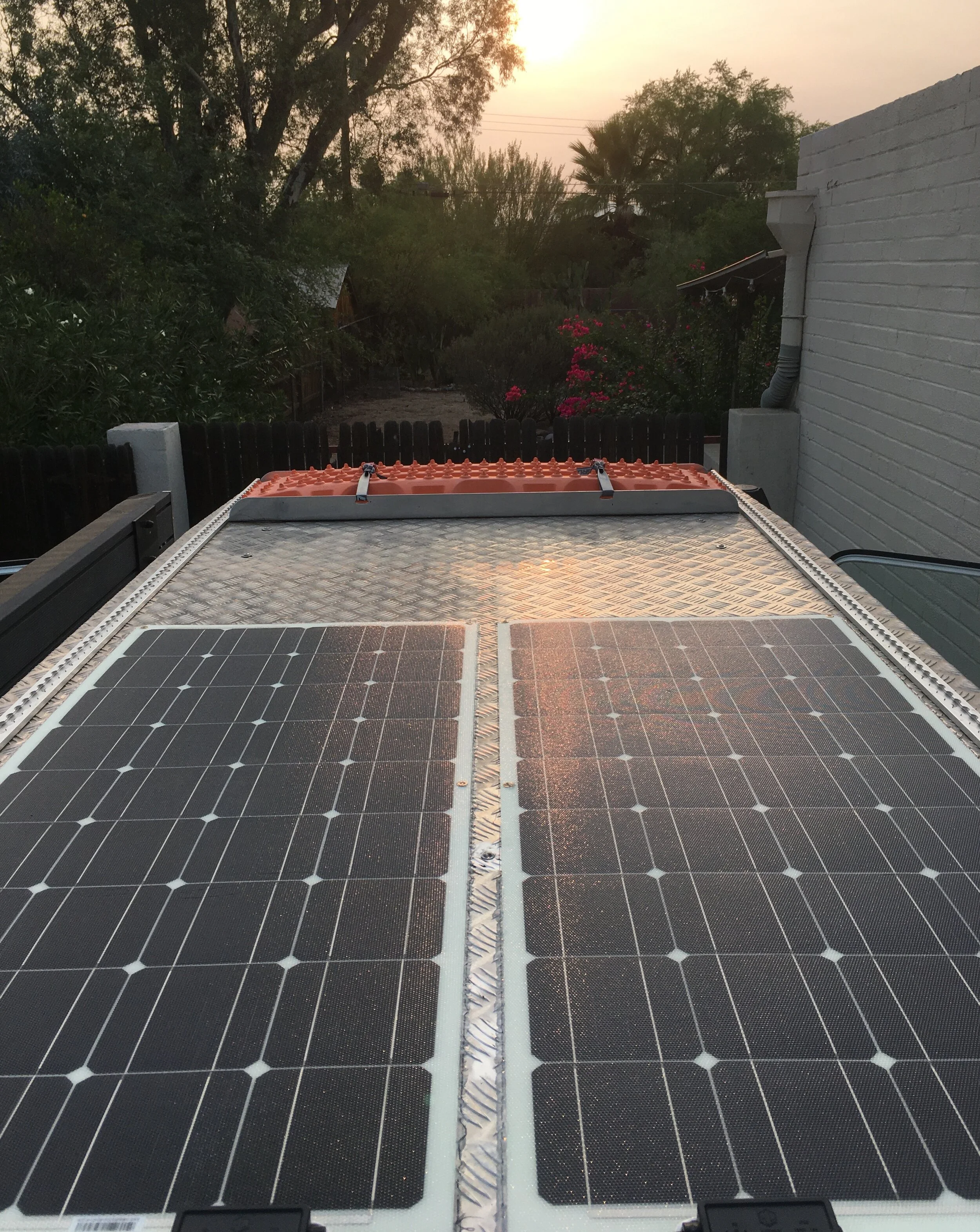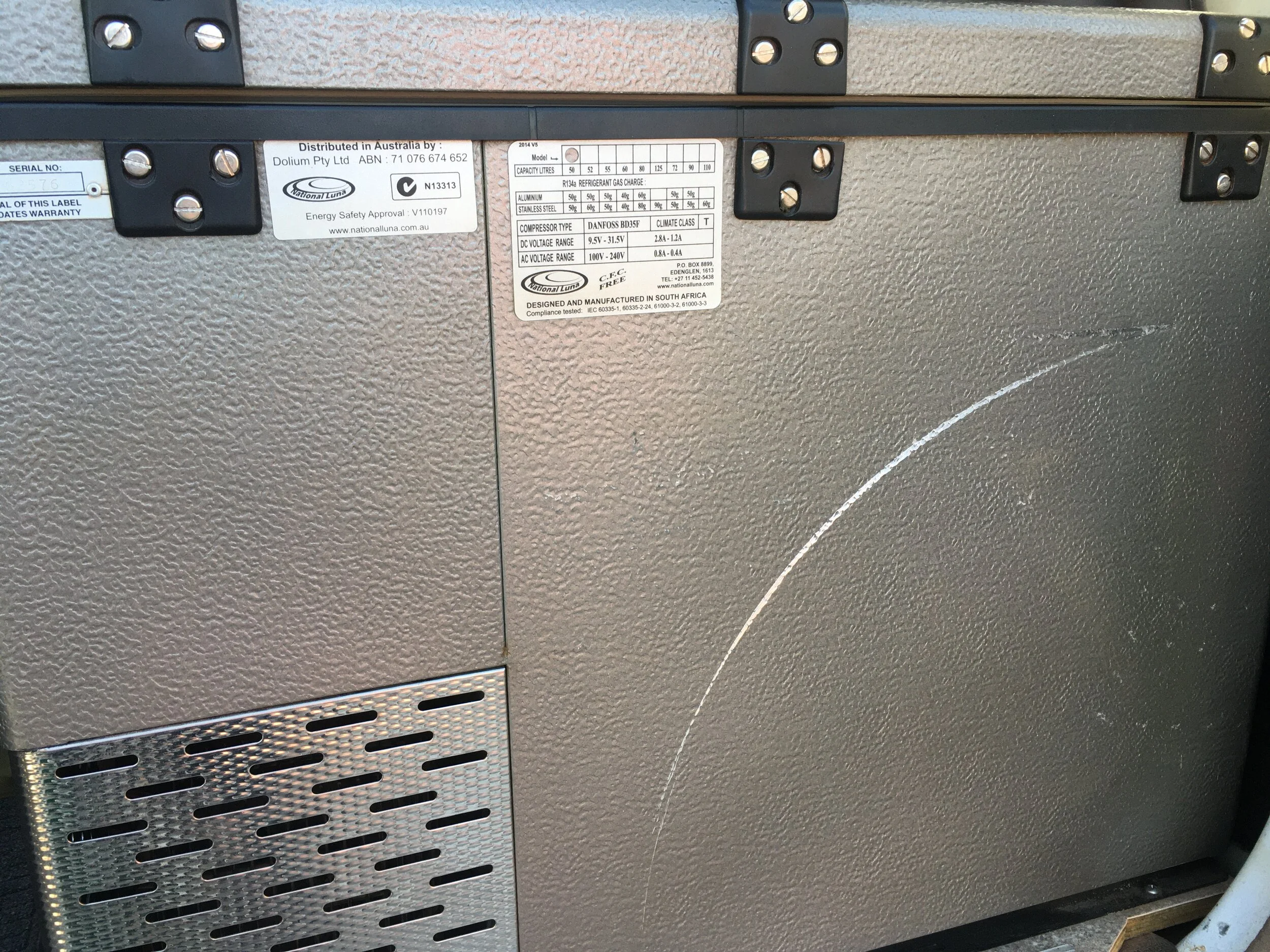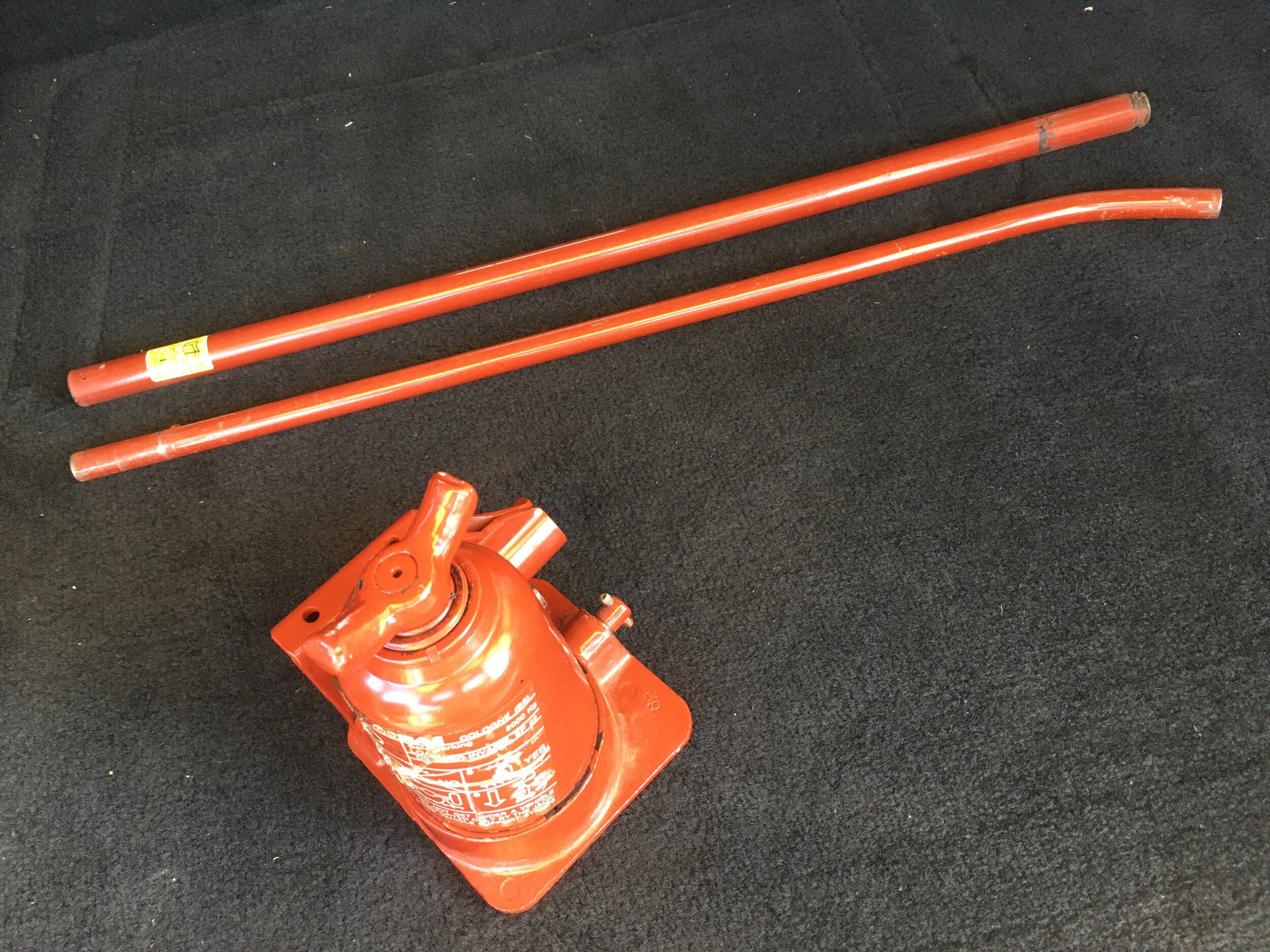
Overland Tech and Travel
Advice from the world's
most experienced overlanders
tests, reviews, opinion, and more
Solar power upgrade . . . preview
A smoky rising sun about to start energizing the Renogy panels
Above is a preview of a significant project we’re undertaking on our 1993 Troop Carrier, to upgrade its electrical supply system. The first step was to replace the single 100-watt panel originally mounted on the Mulgo pop-top with a pair of Renogy semi-rigid 100-watt monocrystaline units. They are secured to the five-bar aluminum checkerplate of the top with Sikaflex 221 adhesive, and bordered with clear silicone caulk. On our Four Wheel Camper we found that a 200-watt solar array was enough to run all the vehicle’s equipment—fridge, lights, etc.—as well as both our laptops and all our camera charging equipment, without resorting to the engine as long as days were mostly sunny. And the efficiency of PV panels continues to improve: Even half covered with solid shade, each of these Renogy panels will still produce 10-15 watts.
To come is an in-depth look at our dual-battery setup. Hint: This will likely involve some exciting lithium technology on the way from Antigravity Batteries, makers of the brilliant Microstart.
Coverting a 12V system from lead-acid to lithium batteries isn’t as simple as dropping them in and hooking up cables. Lithium cells require a specific charging regimen, without which their lifespan can be shortened.
The upsides? First, of course, is the idea of a battery weighing perhaps 25 pounds replacing one weighing 75—an instant 100 pounds taken off the vehicle in a dual system. Far more important, however, is a hugely extended lifespan, as well as hugely increased power density and availability. Can that offset the hugely increased initial cost? We want to find out.
Of concern to anyone contemplating a switch to lithium batteries is the infamous fire danger. Suffice to say that this is strictly a function of the design and quality of the battery—cheap lithium batteries comprise little more than many small cells linked together; expensive ones employ prismatic cells that are individually encased, and controlled by an internal regulator system.
I’m looking forward to exploring this emerging technology.
One-Case Tool Kit– Ep. 1 – Ratchets-Sockets (Online Workshop)
Jonathan’s One-Case Toolkit is legendary. His tool classes regularly sell out at Overland Expo. This free online workshop aired September 12 launches a series dissecting the contents of the One-Case Tool Kit, beginning with what he calls “the most important tool you can have:” ratchet and socket sets.
RESOURCES FROM THE WORKSHOP:
OVERVIEW: THE CONTENTS OF THE ONE-CASE TOOL KIT
From the workshop chat, some of the products and tips mentioned by viewers:
Park Tool hammer is *not* deadblow. https://www.parktool.com/product/shop-hammer-hmr-4?category=General%20Shop%20Tools#tabbed-section
Here's the soft/hard face dead blow I mostly reach for these days. I like this one. (I also have a Snap-on ball peen deadblow that gets used everywhere.)
https://www.kctoolco.com/gedore-247-h-30-combination-hammer-kombi-plus-r-30-mm/
[h/t Don Hiscock]
With that Britool set no longer available, have you found a good alternative. What would you buy if you were putting the set together today?
https://www.exploringoverland.com/overland-tech-travel/2018/10/2/the-versatile-14-inch-ratchet-
Look near the bottom of this blog post from Jonathan
FACOM is part of Stanley-Black & Decker. Really good stuff. FACOM and Proton share a lot of stuff (both premium SBD brands).
This is the Proxxon set in the article mentioned: https://www.amazon.com/Proxxon-23286-65-Piece-4-Inch-2-Inch/dp/B000VD1R8U.
Tekton 1/2 - https://www.amazon.com/TEKTON-2-Inch-6-Point-Socket-Ratchet/dp/B07P7WLYFH/
Torque adapter brand was Facom
For ODB-II…. I have a Gap IIDTool for the Land Rover and in addition to letting you know codes, you can (re) program all the ECUs and modify the suspension. Super helpful for any Land Rover owner. [h/t Troy Angrignon]
I like the ScanGuage, but it doesn’t decode, so you need a manual also. I use it as supplemental gauges; nice bonus that it reads ODBII codes. [h/t David Robinson]
Micro Start https://themicrostart.com
and
NOCO brand (similar to Microstart)
Hacking the Front Runner drop-down table
One of the most useful accessories we added to our Troop Carrier was a Front Runner drop-down tailgate table. It’s perfect for making trailside lunches, as a work place for repairs on small parts, or just a spot to hold small items while loading or unloading. It’s quite strong, and with the plywood extension pulled out there’s a surprising amount of surface area.
However, it has one annoying flaw (at least ours, on our vehicle, does): The table is held closed by two curved extensions of the top frame that snap over the edge of the work surface when you raise it. And when the tension of the clips is adjusted so the table is relatively easy to open, it falls open by itself on bumpy roads or when slamming the door. If ours falls open on the road it rides against the side of the National Luna fridge, and if we don’t notice it has fallen, when we open the door the table rides down the side of the fridge, a corner scoring a nice arc in the cabinet.
I found the solution at a hardware store: a simple sliding-glass-door security pin. I fabricated a mounting plate from a piece of aluminum, drilled and secured it to the edge of the frame, then drilled for the pin, and voilá—an easy-to-deploy table that won’t rattle open on its own.
Front Runner is here.
Neoprene Hi-Lift cover: Don't waste your money
Anyone who’s used a Hi-Lift knows that its otherwise bombproof lifting mechanism is surprisingly prone to jamming when impacted with seemingly minor amounts of dirt and mud. It’s usually easy to get the jack back into operation with a quick dousing of WD40 or virtually any other liquid, but it would be better if you could keep the dirt out in the first place.
One way to do so is to mount the jack inside the vehicle—rarely practical with the 31-pound many-edged beast that is a Hi-Lift. And what about after you use it and it’s muddy? You won’t want to put it back inside dripping goo.
Another approach that helps is mounting it high on the outside of the vehicle. When I had a roof rack on my FJ40 I did this, and indeed it seemed to stay reasonably clean. But retrieving and replacing it was a bit of a pain, and 31 pounds added to the already considerable weight of a ConFer roof rack didn’t help my center of gravity. (As an aside, ARB’s new Base roof rack system offers as an accessory a brilliant one-person Hi-Lift mount that cradles the jack underneath while you’re removing or attaching it.)
Although we drove for one trip in Australia with a Hi-Lift mounted crosswise on the front ARB brush guard, I hate that position (and can now answer, “Yes, I’ve tried it.”). It hampered visibility and hampered access to the engine compartment, and added, yes, 31 pounds in another poor spot to add 31 pounds—right above a heavy bumper and winch stuck way out front. (Finally—and perhaps this is strictly my own prejudice—it had too much of a poseur air about it, as though I was broadcasting that I frequently ventured to places where I’d undoubtedly need it, which is far from true. All it needed as an accent was a pair of limb risers.)
The mounts I see directly under the windshield of Wranglers are better in terms of weight distribution, I suppose, but can’t be very convenient for one person to access; the chances of slipping and gouging the hood must be fairly high. And I worry about the strength of those mounts in the event of a crash—say if you’re rear-ended and that 31-pound jack really wants to come back through the windshield at you.
All this brings me to another way to keep the mechanism clean: simply cover it. This would seem to be axiomatic, yet it took me 30 years before I finally bought one of those zip-on neoprene booties that “protect” just the mechanism.
Why did I put “protect” in quotes? Because I zipped this cover over one of our Hi-Lifts, which then sat on the truck for about a half year without being used. In the course of doing some electrical work on the vehicle I removed the jack, and out of curiosity took off the cover. Of course the plastic zipper (who thought that was a good idea?) took a pair of pliers to undo.
I was astonished to see not only more impacted dirt than I’d ever accumulated in an uncovered jack, but also some significant rust on bare metal parts. It appeared—at least in my impromptu experiment—that the jack cover did an excellent job of containing all the gunk that filtered past the necessarily imperfect seal, as well as holding in whatever moisture our southern Arizona climate let in. I can’t imagine what it would have looked like after the same period in a damper climate.
The cover went in the trash. I’ll just go back to WD40, because I’m not mounting a jack on the brush guard again.
The saga of JUE 477, first production Land Rover
A new book published by Porter Press International tells one of the most fascinating and unlikely tales in the history of the Land Rover: the saga of the very first production vehicle, 860001 (the title refers to its registration plate, JUE 477).
The vehicle was intended for presentation to King George VI, but instead wound up working for a living on farms and mining sites. A farmer named David Fairless bought it 22 years later for the estimable sum of £15, and let it sit in a field until 1998, when on a whim he trailered it to the Series 1 Club’s 50th anniversary rally. When the rally’s attendees realized the import of the 860001 serial number Fairless was deluged with offers, and he stashed the Land Rover in a barn. Not until after his death was 860001 sold—to Sir James Ratcliff, a Land Rover aficionado and more recently the founder of Ineos, the soon-to-be manufacturer of the Grenadier, the spiritual successor to the Defender, and by extension, 860001.
The 128-page book by Martin Port contains 240 photographs, from historical images through a complete documentation of JUE 477’s careful restoration.
Porter Press is here.
Mountains and Mesas Overland Trip
Jonathan and Roseann will be joining the team at 7P Overland to help lead their Mountains and Mesas overland trip this September 20 – 26.
This self-drive, self-catered adventure is a great opportunity to experience the desert and the mountains in a single trip – not to mention that “Colorful Colorado” really lives up to it’s reputation in late September when the Aspen burst into their golden autumn hues. A true overland adventure not too far from home, amongst some of the most spectacular scenery in the world.
This overland trip starts at a basecamp near Moab and ends in Aspen, CO. We’ll comply with safety guidelines for COVID by wearing face masks and enjoying socially distanced campfires. This trip includes a mix of camping, with a hotel finish.
Throughout the trip the team will host overland skills mini-workshops, and we’ll bring a range of Swarovski optics for wildlife spotting and star-gazing.
Roseann will be field-sketching throughout the journey and will work with anyone who is interested in keeping a field notebook or nature journal.
For fee information and to sign up, contact 7P Overland.
Overland Tech — Dissecting the One Case Tool Kit - Ratchet and Socket Sets (free workshop)
Jonathan’s One-Case Toolkit is legendary. His tool classes regularly sell out at Overland Expo. Join him Saturday morning, September 12 as he starts his series dissecting the contents of the One-Case Tool Kit, beginning with what he calls “the most important tool you can have:” ratchet and socket sets.
An interactive Q & A session will be included.
Length: 1 hour
Start time: 10 am Pacific Standard Time / GMT - 7
(Having trouble figuring out time zones?Use this calculator: https://www.timeanddate.com/worldclock/converter.html)
Format: online via Zoom (you will receive a log-in link)
Cost: free
Access: This workshop recording can be viewed here.
Pinnacle product? The Land Rover Coram bottle jack
This photo could spawn a lot of really bad jokes: a jack for a Land Rover, made in Italy, sitting in a Land Cruiser.
Let me explain.
Few manufacturers pay much attention to the jacks they include for changing a flat tire. No salesman is going to pull one out during his pitch, and a lot of people these days simply call AAA if they have a flat, and surf the web on their phone until the truck shows up.
The typical jack on small to medium-sized 4x4 vehicles these days is a scissors jack, barely adequate for an unloaded vehicle and nearly impossible to use for some people if there’s a good load.
My FJ40 came with a bottle jack—a mechanical screw type. It was stronger, but limited in its rise to one extension of the shaft, and still a beast to operate if the Land Cruiser was loaded. Its top post was a simple circular disk and thus lacking in stability.
Land Rover took a different approach with the early Range Rover. Its jack was a bottle type as well—but hydraulic, made by Coram in Italy, with a 2,000-kg rating, which made lifting even a loaded vehicle much easier. In addition, they equipped it with two extra-long operating rods so you didn’t have to be stuffed sideways under the vehicle to work it. It had a double-extending ram for extra lifting height. Finally, the post incorporated a curved top piece that securely cradled the front or rear beam axle of the Range Rover.
The same jack came in early Discoveries as well, and possibly Defenders. However, I have heard that at some point (1995-ish?) the steel body was replace with . . . plastic? And later on a similar-looking jack was substituted, but made in China. All of these I’ve seen were black rather than the ketchup red of the Corams.
I found a nice one on eBay for $40, and it’s been my FJ40 jack ever since. They’re still easy to find, but beware—the downside to hydraulic jacks is that seals can wear and leak, rendering the jack useless (possibly why Toyota stuck with the screw type). If you buy one try it immediately; if it doesn’t work the first thing to do is check the hydraulic fluid level through the rubber plug. If filling it doesn’t help it will need rebuilding, which I understand many hydraulic specialty shops can do but have not confirmed. If at all possible, store the jack upright.
The Coram jack fits into ARB’s excellent jack base, which also accepts either a Hi-Lift or an ARB Jack.
Hint: When using “Search,” if nothing comes up, reload the page, this usually works. Also, our “Comment” button is on strike thanks to Squarespace, which is proving to be difficult to use! Please email me with comments!
Overland Tech & Travel brings you in-depth overland equipment tests, reviews, news, travel tips, & stories from the best overlanding experts on the planet. Follow or subscribe (below) to keep up to date.
Have a question for Jonathan? Send him an email [click here].
SUBSCRIBE
CLICK HERE to subscribe to Jonathan’s email list; we send once or twice a month, usually Sunday morning for your weekend reading pleasure.
Overland Tech and Travel is curated by Jonathan Hanson, co-founder and former co-owner of the Overland Expo. Jonathan segued from a misspent youth almost directly into a misspent adulthood, cleverly sidestepping any chance of a normal career track or a secure retirement by becoming a freelance writer, working for Outside, National Geographic Adventure, and nearly two dozen other publications. He co-founded Overland Journal in 2007 and was its executive editor until 2011, when he left and sold his shares in the company. His travels encompass explorations on land and sea on six continents, by foot, bicycle, sea kayak, motorcycle, and four-wheel-drive vehicle. He has published a dozen books, several with his wife, Roseann Hanson, gaining several obscure non-cash awards along the way, and is the co-author of the fourth edition of Tom Sheppard's overlanding bible, the Vehicle-dependent Expedition Guide.























